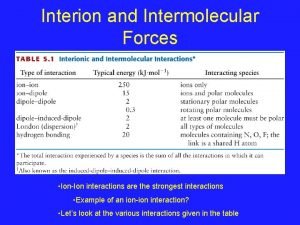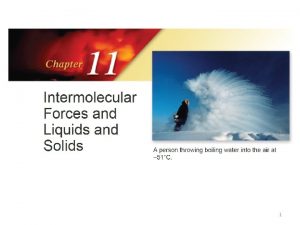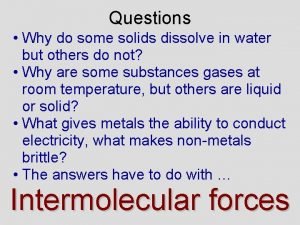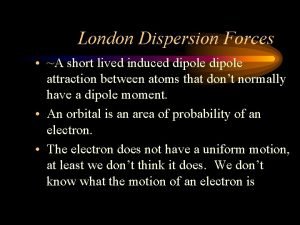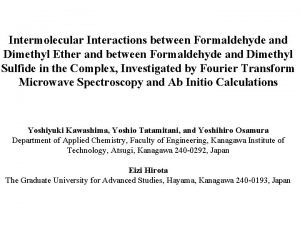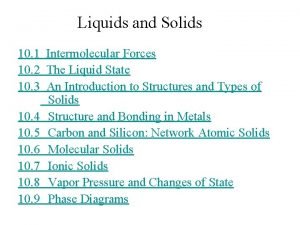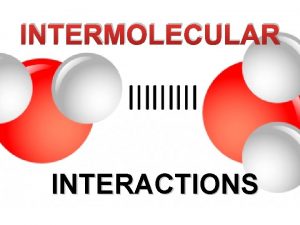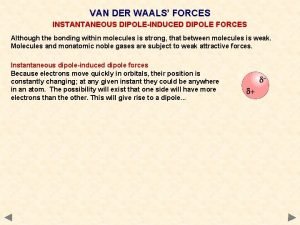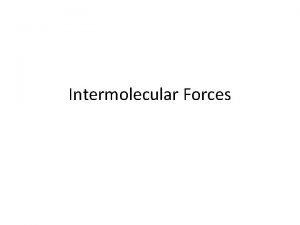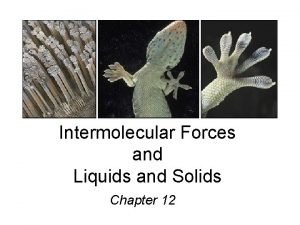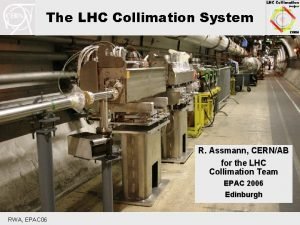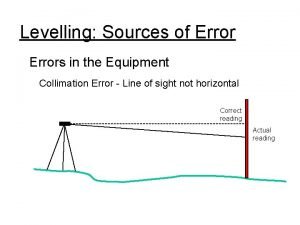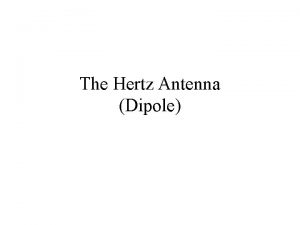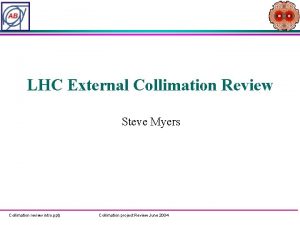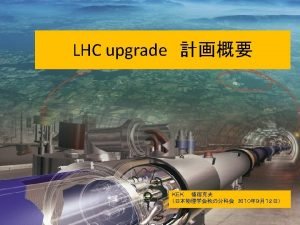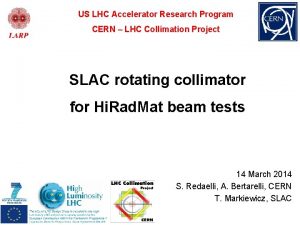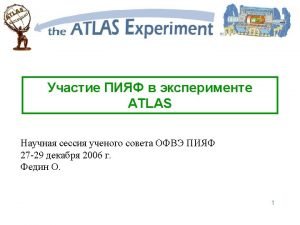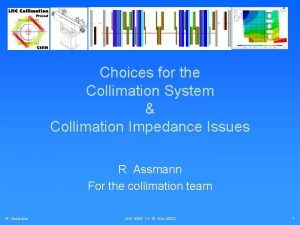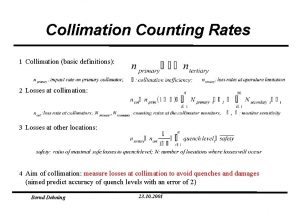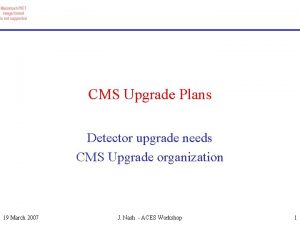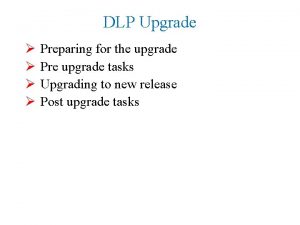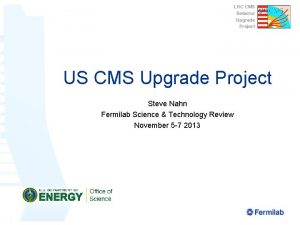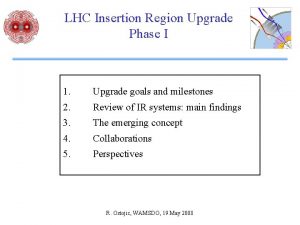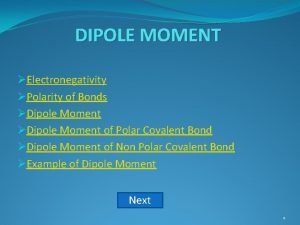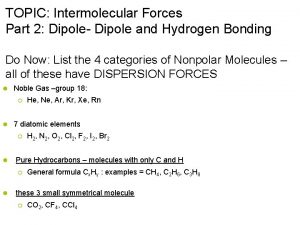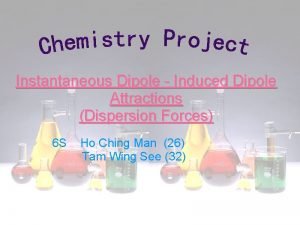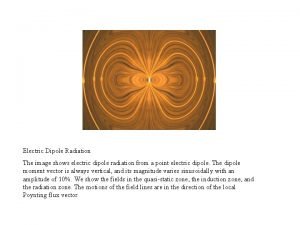11 T Dipole for the LHC Collimation upgrade








![Compare Short sample, operational conditions, and margins with Nb. Ti “Every [superconductor] is a Compare Short sample, operational conditions, and margins with Nb. Ti “Every [superconductor] is a](https://slidetodoc.com/presentation_image/28fa7d8b0de1c375f89e3f845c6db97b/image-9.jpg)







- Slides: 16

11 T Dipole for the LHC Collimation upgrade A Case Study Chris Segal Agnieszka Priebe Giovanni Terenziani Herve Dzitko Michele Bertucci 05/02/13

Wire Parameters and Cabling 1. 42 mm Cu stabilizer matrix with Cu/non-Cu ratio of 1. 5 Strand diameter of 0. 8 mm with filament diameter of 25 um 15. 8 mm Strand Diameter = 0. 8 mm strand diameter Cu/SC ratio Pitch Angle Cable Width Cable Thickness Insulation Thickness Filling Factor K 0. 8 mm 1. 5 16. 03 deg 15. 8 mm 1. 42 mm 0. 15 mm 0. 33

Superconducting area (SC) copper area (Cu) 7 6 5 4 3 2 1 1. 5 : 1. 0

Load Line and Short Sample Conditions Jsc_ss 2, 050 A/mm 2 Jo_ss 677 A/mm 2 Iss 17, 838 A Bpeak_ss 14. 37 T Jsc_op Iop Jo_op B_peak_op 1640 A/mm 2 14, 300 A 541 A/mm^2 11. 5 T 5000 4500 Critical current density Jc (A/mm 2) 4000 3500 3000 Nb 3 Sn, 1. 9 K Load Line 2500 2050 2000 1500 1640 1000 500 0 5 6 7 8 9 10 Bpeak_op = 11. 5 T 11 12 13 Field (T) 14 15 16 17 18 19 20 Bpeak_ss = 14. 37 T 100% field in the coil

Coil Layout The angles needed to cancel B 3 and B 5 are (48°, 60°, 72°) or (36°, 44°, 64°) There is a system of two equations, but with three unknowns, there is a degree of freedom allowing for a set of solutions rather than only one Either layout removes the sextuple and decapole contribution Inner layer needs more wedges since its closer to aperture α 3 α 1 α 2

EM Forces, stress Fx = 2. 53 MN/m Fy = -2. 25 MN/m σ = -265 MPa

Dimension iron yoke, collar, shrinking cylinder iron yolk dimensions shrinking cylinder (support reaches 90% Iss) collar Dipole Section 172. 43 mm 6. 32 mm 40 mm

Limitation in Magnetic support structure design • Iron can’t take more than 2 T (Bsat) • Thickness of iron yoke = 21 cm • Magnetic pressure on iron yoke
![Compare Short sample operational conditions and margins with Nb Ti Every superconductor is a Compare Short sample, operational conditions, and margins with Nb. Ti “Every [superconductor] is a](https://slidetodoc.com/presentation_image/28fa7d8b0de1c375f89e3f845c6db97b/image-9.jpg)
Compare Short sample, operational conditions, and margins with Nb. Ti “Every [superconductor] is a [great superconductor]. But if you judge [Nb. Ti] by “Everybody is a genius. But if you judge a fish by its ability to climb a its ability to [upgrade the LHC for high luminosity], it will live its whole life tree, it will live its whole life believing that it is stupid. ” believing that it is [a poor superconductor]. ” -Einstein 11 T (Nb. Ti saturation)

Cos(θ) vs Block • J ~ Cos(θ) • Self supporting structure • Circular opening, compact coil • Easy winding, has long history of use • Block cable is not keystoned, perpendicular to the mid plane • Additional internal structure needed • Ratio central field/current density is 12% lower less effective than cosθ • Bss is around 5% lower than by cosθ

High Pre-Stress vs Low Pre-Stress • Stable plateau but small degradation • Less damage for the Sc parts. • Optimal training • Unloading but still good quench performance

Support Structure Collar-based vs Shell-based • Low field: shrinking outer shell • High field: collars + outer shell • Very high field: bladders, intermediate coil supports. • If a magnet training does not improve from 4. 2 to 1. 9 K, there is a mechanical limitation.

Support Structure: Collar-based vs Shellbased Yoke Shell Advantages: • Proven coil positioning • Proven length scale-up R&D issues: • Deliver required pre-stress • Max. stress at assembly Bladder Pad Axial rod Key Coil Filler Advantages: • Can deliver very high pre-stress • Large pre-stress increase at cool-down • Easily adjustable R&D issues: • Coil alignment accuracy • Length scale-up

Courtesy of Peter Lee, Florida State University

Courtesy of Peter Lee, Florida State University

References CERN Accelerator School on Superconductivity lectures (2013): • Ezio Todesco, "Magnetic Design of SC Magnets" • Pierluigi Bruzzone, "Superconducting Cables" • Fernando Toral, "Mechanical Design of SC Magnets" Thanks for listening!
 Ion-dipole interaction example
Ion-dipole interaction example Induced dipole
Induced dipole Capillary action
Capillary action Dipole induced dipole interaction
Dipole induced dipole interaction Dispersion forces vs dipole dipole
Dispersion forces vs dipole dipole Example of ion dipole
Example of ion dipole Dimethyl ether dipole dipole
Dimethyl ether dipole dipole Dipole-dipole attractions
Dipole-dipole attractions Dipole induced dipole
Dipole induced dipole Instantaneous dipole induced dipole
Instantaneous dipole induced dipole Vander waals force
Vander waals force Intramolecular forces
Intramolecular forces Dispersion forces vs dipole dipole
Dispersion forces vs dipole dipole Surface tension intermolecular forces
Surface tension intermolecular forces Star testing telescope
Star testing telescope And a modular collimation system
And a modular collimation system Errors in levelling
Errors in levelling
